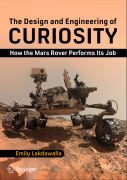Book Review: The Design and Engineering of Curiosity
by David Kohanbash on February 2, 2022

As soon as I saw this book existed on Amazon, I instantly wanted to read it. It is not often that I see a book dedicated to the detailed engineering design of a complex robotic system. The Design and Engineering of Curiosity: How the Mars Rover Performs its Job by Emily Lakdawalla did not disappoint. It is a fascinating read about the details of the Curiosity Mars rover and the engineering of the various systems on board. As the author says “understanding how the hardware worked was crucial to narrating the mission”, we often skip this step and then dont truly understand how or why things happen.
Note to author of the forward: Don't worry, anthropomorphizing our robots is not silly. We all do it... This book starts out with chapters 1-3 giving a background and setting the stage for the rest of the book. In particular chapter one is like a basic systems engineering class and how things work in the real world (as opposed to just the perfect world of the classroom). Chapters two and three talk about various system/hardware issues and the performance of those systems.
Chapter four starts digging into the various subsystems. This section does not have a good high level overview of the full system nor a good explanation of how all the systems interact with each other. A high level system diagram would have been very beneficial for seeing how everything actually connects, is powered, and communicates with other modules. However, each subsystem has a very good overview of that subsystem, followed by details of the design and operation. I also really like how the performance and the anomalies of each subsystem are also presented. For the different subsystems there are images of the actual hardware. While the actual hardware images are great to have, I think more block diagrams would have been useful. (Note: Overall the images are very good and labeled well for you to see the various components).
Some of the subsystems discussed include:
- Power System
- Avionics
- Thermal
- Communications
- Mobility
- Science payload (chemical, environmental, etc..)
- Sample collection and handling
- Cameras
The avionics section has a nice discussion on Mars rover software. The mobility section also has a really nice discussion on wheel issues (See here for more details on wheel design). It is nice to see that they followed Reds Rule when selecting mobility actuators. It would have been nice if the testing section was expanded upon (granted, I enjoy robot/system testing more then most people).
Chapter six The Mast, Engineering Cameras, Navigation, and Hazard Avoidance is really interesting for getting into the minds of the designers for how Curiosity should be operated.
After reading this book I am sure that I could spend many hours drinking a beer and listening to the author tell stories about Curiosity, Mars, and the people who developed these systems. Emily does a great job making the book easy to understand and avoids the use of jargon and abbreviations that NASA is famous for (I think my first time in a NASA PDR (preliminary design review) I only understood half of what was being said due to the use of jargon and acronyms). There is a lot of really good imagery in the book showing the systems being discussed. I am happy (and impressed) that Emily was able to get this book approved by the NASA/JPL export control reviewers.
I think this is a great book and any engineer who develops (or wants to develop) systems should read it. One problem I see with students and junior engineers is not being able to see how their system fits into the big picture and the ability to understand the various components needed to build a real life system. I think this is the only book that I am aware of that presents all the required engineering elements to design and build a complex robot system. This book also helps show the real world of systems engineering. For experienced engineers it is also useful to read. Often with experience we can get boxed into specific approaches, opening our eyes to how others solved a problem helps expand our mental toolbox. For both jr and experienced engineers the discussions of the various sensing systems will likely have some new information for you.
My final rating for this book is 4.8 of 5 stars. The primary reason for taking away some fractional stars (or should I use planets for a Mars book?) is the lack of a systems overview and diagram. An overview system diagram I think is needed to improve overall system comprehension, and system diagrams of subsystems (not just pictures) would have been useful. I also would have liked to see a full section on system testing, but I did not take away any stars/planets for that.
Update: Please see below for the response from the author (and thank you to the author for the feedback).
I would like to thank Springer for providing me with a free electronic copy of this book for review.
Some words of disclaimer:
I have never met the author of this book and the opinions above are mine (feel free to disagree with me in the comments below).






Leave a Reply